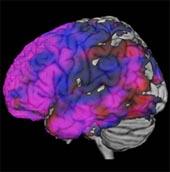Semantic cognition
Semantic cognition - semantically driven verbal and nonverbal behaviour - is made up of two interactive components:
- Semantic representations (conceptual knowledge)
- Semantic control
Research on semantic representations has a long history based in a variety of disciplines, while notions of semantic control are newer and have arisen primarily in the context of functional neuroimaging. To gain a unified theory of semantic cognition and its breakdown, therefore, it will be necessary to understand each part - representation and control - and also how they interact with each other.
The nature of the group reflects the core aims of our research approach:
- It is multidisciplinary (including neuropsychology, cognitive neuroscience, neuroimaging, TMS, computer science, linguistics and speech therapy)
- It produces high-quality basic and clinically-applied neuroscience research with the explicit aim of encouraging an active interaction between scientists and clinicians
- It develops new methods and approaches
- It is a rich environment for the many PhD students and postdocs to learn and succeed
Publications
Research projects
- Research projects: semantic cognition
Ongoing and completed studies plus student PhD/MPhil projects

